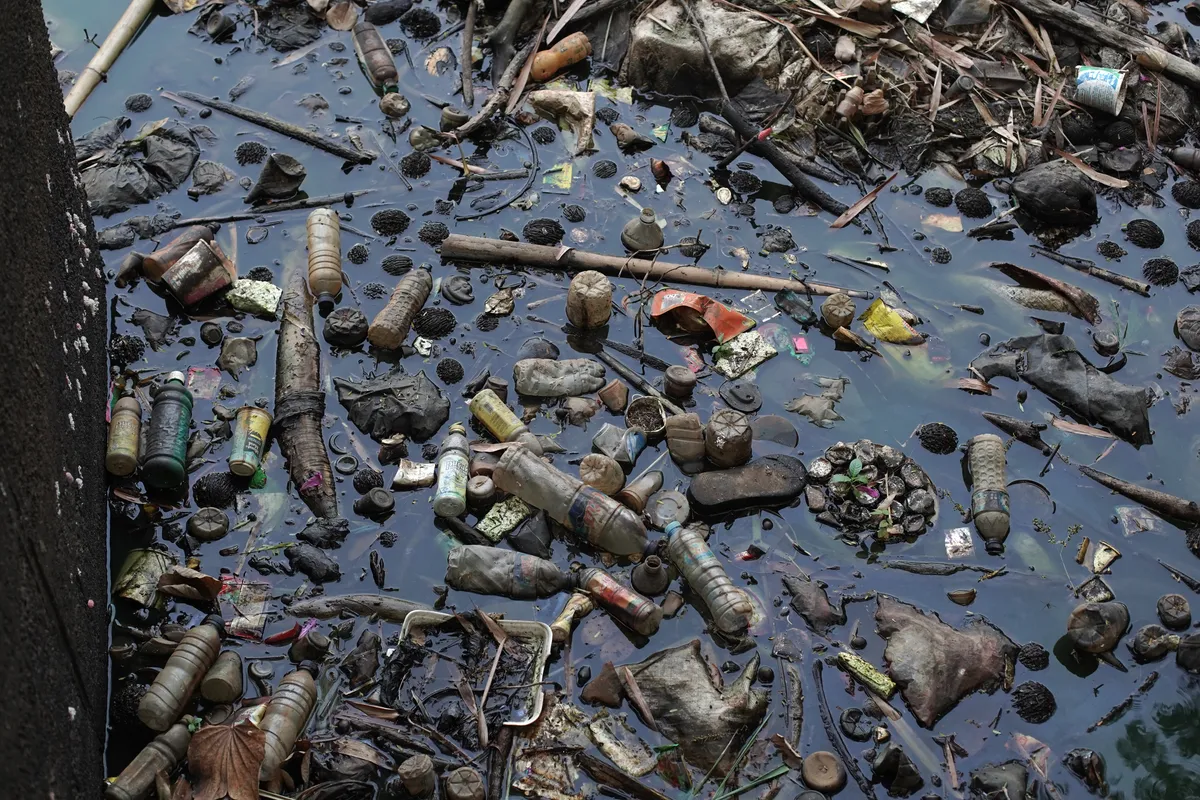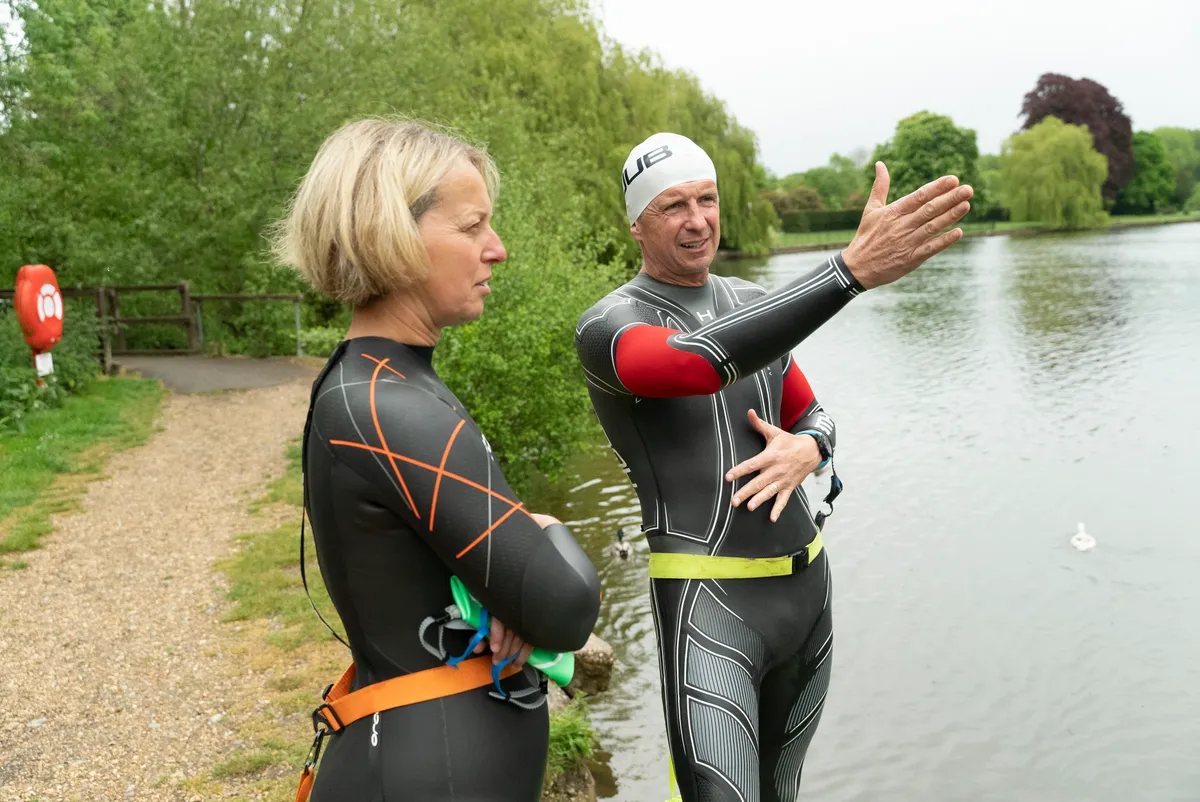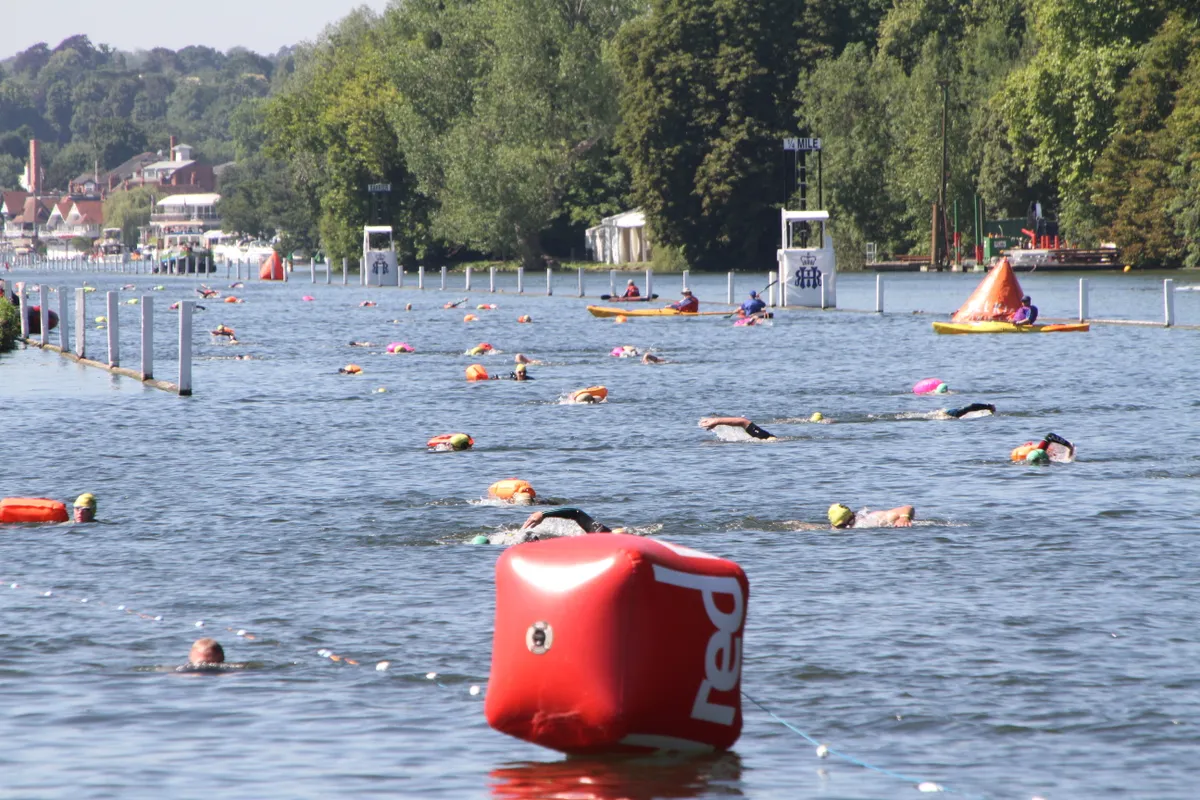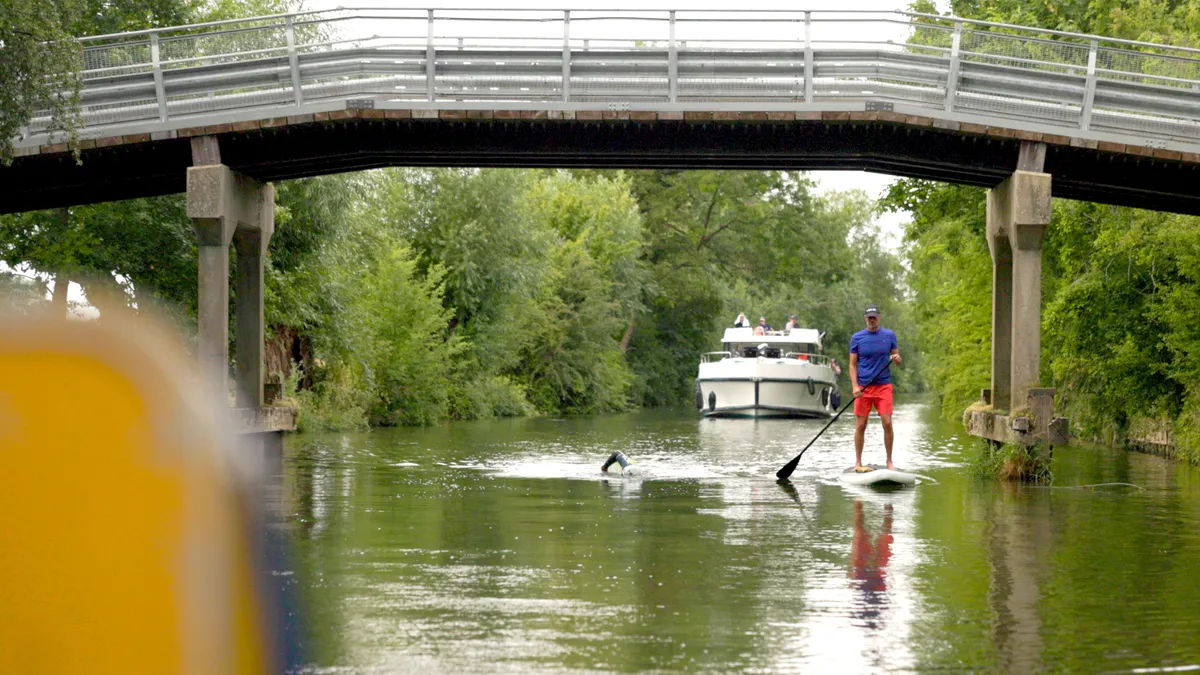The river is on fire. Flashes of orange, crimson, yellow and magenta ripple across the water, reflected from the midsummer sunset above.
Along the line of the riverbank, one man rhythmically swims his way across, each arm darting into the water and extending gracefully in front of him, causing the colours to swirl and dip in his wake. This moment is, quite simply, one of the most beautiful things I have ever witnessed in my forty-something years on this planet.
I’m on the River Thames as part of the support crew assisting 220 columnist and leading sports scientist Professor Greg Whyte in his attempt to swim the 125 miles of the upper Thames in a world record time, while raising money and awareness for the RLSS and RNLI.
I’ve been lucky enough to see the challenge unfold first-hand – and along with it, the changing scenery of the UK’s largest river. You may wonder why we’re talking about rivers in a triathlon magazine.
After all, don’t we all train in venues set up for openwater swimming with nice, convenient buoy markers to sight off? Aren’t rivers a bit hazardous and polluted for serious headdown training? In the lead-up to supporting Greg on his mega swim, we decided to find out…
Call of the wild

Not being near the coast, I do tend to rely on local managed lakes and quarries for my swims. These have real benefits in that they have marked courses, regular checks on water quality and lifeguards on duty – and none of these safety points are to be underestimated.
In recent years open-water swimming has exploded in popularity though, meaning some managed lakes are bursting to capacity. Add to that the cost of fuel (yikes) and the environmental impact of driving – my local venues are all at least a 40-minute drive away – and local ‘wild’ swimming instead can start to look more and more attractive.
But where to start? I live in Chippenham in Wiltshire, a five-minute walk away from a river, but have never swum there. A check of local forums suggests a couple of folk do dip now and again, but friends in the local canoe club tut and make noises about sewage, reeds and gippy tummies.
A nosy at likely spots reveals difficult steep and muddy entry/exit points and a lot of weeds, plus I’m unsure how clean it is. That ruled out for the meantime then, I turn to 220’s Greg Whyte to see if he’ll take me for an inaugural river swim.
Handily, Greg is planning his solo swim of the Upper Thames in a few weeks, which will see him returning to the route he famously coached David Walliams for, so is well up to speed on river safety.
The day before our swim, though, and things have gone wrong already. Turns out sewage has been released into the stretch of water we were planning to do our photoshoot in.
People have seen turds floating down the river. Great. If this can happen in one of the most famous stretches of river in the UK, it doesn’t bode well for my little local waters. A plan is hatched to move upstream.
River or sewer?

We don’t have the space available in this short feature to address the problem of pollution in the UK’s rivers (and coastal areas) but there are a wealth of resources which are definitely worth your time (see boxout far right).
The Rivers Trust reports that of England’s rivers only 14% are in good ecological health, and every single one fails to meet chemical standards. “Of these failing rivers, agriculture impacts nearly two thirds (2,296 river water bodies); the water sector impacts over a half (2,032 river water bodies); and the urban and transport sector a quarter”.
The pumping of raw sewage into the waterways as a result of overflow discharge by water companies is “the single activity with the most widespread impact on rivers […] This impacted 1,602 river waterbodies in 2020 (43% of river water bodies).
Impacts from raw sewage spills via storm overflows, of which there were 403,171 recorded in 2020, contributed towards 12% of river water bodies failing standards. As a whole, the water sector contributed more than half of our river water bodies (53%) failing to achieve good status.”
Top tips for safety in the water
Never swim alone - Always have someone in the water or on the riverbank with you who can help if you get into difficulties, plus a mobile.
Essential kit- Never swim in ‘wild’ swimming spots (sea, rivers, etc.) without a tow float and brightly-coloured swimming cap for visibility. Make sure you have some layers ready to help you warm-up afer cold water swims.
Plan your entry and exit - Rivers can flow deceptively quickly, so make sure you know where you’ll be able to get in and out of the water safely.
But how is this permitted? The sewage overflows were only ever designed to be used in ‘exceptional circumstances’, but the 2021 Water Quality Report from Surfers Against Sewage reports that these approximately 21,500 legally permitted Sewer Overflows and pumping stations in England and Wales “are increasingly seeing discharge notifications issued during what many would consider to be normal rainfall events”.
Long story short, the overflows aren’t intended to be used as much as they are. Madness? You bet – and Greg Whyte is equally unimpressed when we meet up:
“Sewage and pollution in the rivers are certainly something that would deter a lot of people from swimming in their local rivers. To my mind, what I’m looking at there is a river. What I don’t want to be looking at is an open sewer. Those organisations that feel that it’s right and proper to dump sewage into the rivers? I think it’s an absolute disgrace.”
Time to change
There is hope, though. A groundswell of voices are asking for change, and at the time of writing 31,812. people have signed the SAS Rivers Petition (40,000 are needed) to demand the government create 200 UK River Bathing Waters by 2030.
“Bathing Water Designation creates blue spaces where water quality is officially monitored for harmful bacteria and viruses,” says the campaign, “with legal obligations placed on industry to stop sewage and agricultural pollution. This provides a powerful indicator of the state of our water and drives real change.”
Campaigning to swim

At the moment there’s only one site in the UK with this hard-fought-for status – near Ilkley in Yorkshire – while close to Bristol, the group Conham Bathing are campaigning hard to get Bathing Water status.
“Cleaning up our rivers so that they are safer to enjoy is essential if we want everyone in the UK to have access to healthy nature and blue spaces close to home,” says Rebecca Duncan from The Rivers Trust.
“We know that to significantly increase the number of inland bathing waters in England – and across the UK and Ireland – it’s absolutely necessary to work in partnership.
"It takes lots of enthusiastic and dedicated members of the public, along with NGOs and local authorities to champion bathing waters and push for investment into healthy catchments with nature-based solutions wherever possible. It’s clear that there’s immense public appetite for this and we look forward to playing our part in making it happen.”
Campaigning and change are undoubtedly much needed. But these things will take time. So back to the current day and our swim training. Is there hope? The Rivers Trust has a very useful interactive map online with brown markers of varying size (ick) showing the number of sewage overflows and how prolific they are.
In my home town there are three close to the spot I was planning to swim – so that looks less and less an option. At my inaugural swim spot in Marlow with Greg, though, we are now upstream of the problem and ready to get in the water.
Into the water

Trying hard to shift my brain from the thought of raw sewage, I listen as Greg gives me a rundown of the key safety points when finding a river spot to enter the water, and they’re not that different from the ones you’d observe in a managed venue.
“Number one, never swim alone,” says Greg. “Plus, although a spot might look glorious, get to know it first – the speed of the flow, depth of the water, safe entry and exit points. Start with a short swim and gradually extend your time and distance as you get to know the area and how the river behaves.
“Depending where you are, you may be quite isolated and with a lot of river traffic around you. Here you will have motorised boats to look out for, so always use a tow float for visibility, plus rowing boats on some stretches, which are silent and move quickly and won’t see you – so look behind you regularly as well as sighting forward.”
The sun starts to peek out as we make our way down a convenient stone access point, slipping into the water and bobbing for a few seconds before starting to swim upstream (against the current, so we don’t exhaust ourselves before swimming back).
It’s a calm day and doesn’t feel arduous, but I’m struck by how low down we feel next to the riverbanks. I quickly grasp how difficult it could be to get out again without good, pre-planned access points.
Birds twitter, flying in and out of the reeds and ducks swim ahead. The ever-changing scenery means the time flies by and it’s a refreshing change from the familiar surroundings of the swim loop at my local managed venues.
I remark to Greg that I’m reminded of reading The Wind In The Willows as a child. “I’m not surprised!” Greg replies. “It was written close to here.”
Riverboats sail past and most are friendly, slowing to wave. All too soon we’ve reached the 500m point – time to turn back.
We’re going downstream now, though, and although it didn’t feel like there was much of a current, we’re suddenly flying. It’s a rush to be moving so quickly, but I’m also gutted that the swim is over so quickly.
River racing

Moving on a few weeks and it’s time to venture into the rivers again. First up, I have a place in the Henley Swim Festival. It’s a glorious, baking-hot weekend and with the water at 20.7°C the river feels wonderful. It’s a touch reedy and tastes more ‘organic’ than I’m used to, but the events are loads of fun.
From Henley, I join Greg’s ‘Whyte Water’ team for his World Record swim attempt. The route takes us from the start of the navigable Thames in Lechlade to Teddington, the end of the non-tidal river.
If I thought my short swims so far provided beautiful scenery, then that was a mere taster for the scenes that greet us throughout the week on the crew. Greg is swimming from the crack of dawn until late at night each day, taking only a couple of hours’ sleep, so we’re treated to misty, chilly sunrises, blazing hot days and those inferno-like sunsets.
There are some stunning organised river swims in the UK, so if you fancy a long swim with full safety support, here are our picks:
- Henley Swim Events - Choose from a calendar of great swims on the Henley Regatta course – including the Henley Classic, the Henley Swim Festival, Pub to Club and the whopping Thames Marathon.
- The Bantham Boomerang/Swoosh - The Swoosh is well-established, but the Boomerang (where you swim up the estuary as the tide turns) is new for 2022.
- The River Dart 10km - From the same team as the Swoosh, this is a slightly longer but no less iconic event taking in the famous river estuary.
- Wild Wye Swim - First held in 2017, two distances are available – 10.5km and 7km – and centre around the village of Symonds Yat in Herefordshire.
- Hever Castle Triathlon - If you fancy incorporating a river swim into your triathlon racing, you can’t beat Hever IMHO. Starting at the Italian Loggia at the castle, you swim up a lake and then into a river tributary before hopping on your bike.
The environment is ever-changing as well. We see high reeds and overhanging woods, fields and pastures. The river moves from narrow and claustrophobic to wide and majestic, and the wildlife turns us all into amateur nature-spotters.
I see my first-ever wild otter, the blue and orange flash of kingfishers and screeching kites overhead. We’re forever on-guard against families of swans, who aggressively guard their young, while packs of geese need navigating with caution.
Less positively, Greg spots sewage as he swims through more urban areas and on day three of the challenge is struck with a violent bout of vomiting and diarrhoea. Whether from polluted water or the gastric stress of so much twisting while swimming – or a combination of both – is unclear.
As noted, boats need careful watching. The locks are a joy though, with helpful lock-keepers updating us on water conditions and algae blooms. Along the way swimmers and triathletes join us at their local spots and are eager to share local knowlege.
Swim and swoosh

As the week progresses a shoulder injury becomes more and more debilitating, and on day five the decision is taken to pause Greg’s swim until he can seek medical advice. I’m sad to leave the crew, but I’ve got less than 24 hours until my next – and final – river adventure, so there’s no time to waste.
This one’s a bit different as I’m taking on the Bantham Swoosh, one of the most famous events in the open-water swimming calendar. The event is 6km along the estuary reaching from Aveton Gifford in Devon down to Bantham on the coast.
Having had a very dry summer so far we had very little flow on the Thames, so I’m keen to feel the full force of a river’s current! Once again, I’m struck by the beauty of my surroundings as the narrow river winds its way into the wider estuary.
Murky water gives way to clear and becomes increasingly salty as we swim towards the sea, while as the kilometres fly by jellyfish and tiny crabs become a novel change from the river wildlife.
The current itself is noticeable from the off, but builds throughout the swim. The organisers time this event just right so we have the most flow, and having a safety team on hand to guide us (and stop us swimming into boats and down little side tributaries and creeks) is a huge reassurance.
The final kilometre is pure joy – there’s no need to swim and most competitors have pulled their goggles onto their heads and are swooshing (there’s no other word for it!) along.
The Swoosh marks the end of my adventure, so the big question is – will I continue to wild/river swim? Experiencing such beautiful surroundings makes it tempting.
There are a couple of spots closer to home that I’m keen to try – Farleigh Hungerford is a famous one not too far away from me in Chippenham – and I also have a race place in the Dart 10km later this summer.
But researching the pollution crisis facing the UK’s rivers has also been a real eye-opener, and I’d encourage anyone who enjoys open-water swimming to add their voices to the campaigns mentioned in this feature.
The take-home? The UK’s rivers are uniquely beautiful, but we’re fast running out of time to protect them. I’d still encourage you to explore your local waters, though, and maybe one day, we can enjoy a swim in all the UK’s rivers safely.
Keen to find out more about the pollution challenges facing the UK’s rivers and coastal waters and how you can get involved? Check out these resources:
Surfers Against Sewage
Extensive resource sharing the extent of sewage discharge into UK rivers and coastal bathing waters, as well as information on how you can get involved and try to encourage change. Also includes a ‘sewage map’ to help swimmers and surfers check when water isn’t safe to use.
Safer Seas & Rivers Service
Download this app from Surfers Against Sewage which gives you an interactive UK map, along with symbols telling you if any water quality alerts are in place for 350 UK beaches (and a handful of inland spots). Real-time alerts are supplied by water companies as well as the Environment Agency and other bodies.
The Rivers Trust
Conservation experts dedicated to helping the UK’s rivers thrive. Working with partners, their goal is to create wild, natural and healthy rivers which can be enjoyed by all. Website features a very helpful interactive sewage map, which shows you where sewage is discharged into the UK’s rivers.
The Environment Agency
Government body founded in 1996 to protect and improve the environment. Within their remit is the responsibility for water quality and resources, conservation and ecology, as well as regulating major industry and waste and the treatment of contaminated land.
BART
Bristol Avon Rivers Trust (BART) is a charity which delivers education, land and river management advice and practical river restoration work throughout the Bristol Avon catchment.
Main images: Ben Hull
